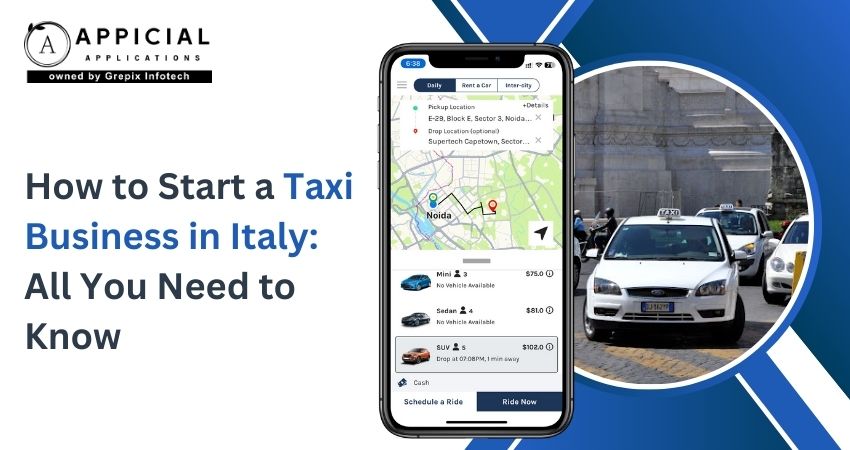
How to Start a Taxi Business in Italy: All You Need to Know
Starting a taxi business in Italy presents an exciting opportunity to tap into the country's bustling urban centers, iconic tourist destinations, and growing need for dependable transportation. With careful planning and adherence to regulations, you can build a profitable enterprise. Key steps include obtaining the necessary licenses, registering your business, and adhering to local laws governing taxi operations. Understanding your target market and investing in a well-maintained, efficient fleet is essential for success. Additionally, leveraging modern technology, such as mobile booking apps, can set you apart in a competitive market.
Starting a taxi business in Italy is a rewarding yet demanding endeavor. By understanding the industry, conducting thorough research, and adhering to legal requirements, you can set a strong foundation for your business. Incorporating technology, providing exceptional customer service, and maintaining high safety standards will help you stand out in a competitive market. With careful planning and persistence, your taxi business can become a trusted name in Italian transportation.
This guide provides the tools to launch and grow your taxi business effectively.
Starting a taxi business in Italy offers lucrative opportunities in its bustling cities and tourist hotspots but requires thorough planning and adherence to local regulations. Success hinges on obtaining licenses, understanding market demands, and maintaining a reliable vehicle fleet. Entrepreneurs must research competitors, identify target audiences, and develop a solid business plan covering costs, pricing, and operations. Leveraging modern technology, such as booking apps and dispatch systems, is vital for efficiency and customer satisfaction. Appicial Applications, a leader in taxi app development, provides tailored solutions to streamline operations, helping businesses thrive in Italy's competitive and dynamic transportation industry.
How To Start a Taxi Business in Italy: Step-by-Step
1 Understanding the Taxi Business in Italy
Overview of the Taxi Industry
The taxi industry in Italy plays a vital role in the country’s transportation network. Whether in the historic streets of Rome or the scenic coastal towns of Amalfi, taxis remain indispensable for locals and tourists. The market has seen steady growth due to rising tourism, urbanization, and the need for flexible travel solutions.
Importance of Taxis in Italian Transportation
Italy’s diverse transportation system includes buses, trains, and private vehicles. However, taxis fill the gap for personalized and on-demand services. From airport pickups to late-night commutes, they offer convenience and comfort that other modes cannot always guarantee.
Challenges and Opportunities
While the taxi industry presents opportunities, it also comes with challenges such as competition from ridesharing services, fluctuating fuel costs, and regulatory hurdles. Entrepreneurs need to balance customer expectations with operational efficiency to thrive.
2 Research and Market Analysis
Assessing Demand for Taxis in Key Cities
Understanding where the demand for taxis is highest is critical. Major cities like Rome, Milan, Florence, and Naples are prime locations due to their dense populations and high tourist influx. Conduct market research to identify underserved areas or niche markets, such as luxury or eco-friendly taxis.
Analyzing Your Competitors
Analyze existing taxi companies in your target location. What services do they offer? What are their pricing models? Identifying gaps in their offerings can help you position your business uniquely and attract customers.
Identifying Your Target Audience
Who will you serve? Is it tourists, business travelers, or locals? Each segment has unique needs, such as language preferences or service quality expectations. Tailoring your business to your audience will enhance your appeal and profitability.
3 Legal Requirements for Starting a Taxi Business
Licenses and Permits
Starting a taxi business in Italy involves obtaining various licenses and permits. Here’s what you need: Taxi Driver’s License: Every driver must pass a driving test and meet certain criteria to obtain this license. Business Operating License: You’ll also need a specific license to legally run your taxi service, which varies by city.
Understanding Local Taxi Regulations
Italy has stringent taxi regulations, including fixed fare zones and vehicle specifications. Stay updated on these rules to avoid fines or legal complications. For instance, cities like Rome have capped the licenses, making it competitive.
Insurance and Liability Coverage
Ensure your taxis are insured against accidents, theft, and damages. Passenger liability coverage is mandatory to protect your business from legal issues arising from accidents.
4 Creating a Business Plan
Key Elements of a Taxi Business Plan
Your business plan acts as a blueprint for success. Key elements include: Business Objectives: Define your goals, such as market share and revenue targets. Financial Planning: Outline your funding sources, projected income, and break-even analysis.
Budgeting for Your Taxi Fleet
Fleet acquisition is your biggest expense. Decide how many vehicles you’ll need, their make and model, and associated costs like maintenance and insurance.
Setting Competitive Pricing
Your pricing strategy should reflect local fare regulations, operational costs, and competitor rates. Offering promotional discounts during the initial phase can attract customers.
5 Acquiring Vehicles for Your Taxi Fleet
Choosing the Right Vehicles
The choice of vehicles will depend on your business model. For example, a standard taxi service may require compact sedans, while a luxury service might need high-end models. Ensure the cars comply with Italian safety and environmental standards.
New vs. Used Cars: Pros and Cons
Purchasing new vehicles ensures reliability but involves higher costs. On the other hand, used cars reduce initial investment but may lead to increased maintenance expenses. Evaluate your budget and long-term goals before making a decision.
Sustainability Considerations
With growing awareness of climate change, eco-friendly taxis are gaining popularity. Investing in electric or hybrid vehicles can reduce operational costs and attract environmentally conscious customers.
6 Setting Up Your Business Operations
Registering Your Taxi Business
Once your business plan is finalized, the next step is registering your taxi business. This involves choosing a business structure, such as a sole proprietorship or limited liability company (LLC). Register your business with Italy's Chamber of Commerce and obtain a VAT (Value Added Tax) number, which is essential for legal operations. Additionally, ensure you adhere to municipal registration processes specific to the city where you plan to operate.
Hiring and Training Drivers
Recruiting skilled and professional drivers is critical for customer satisfaction. Look for individuals with valid taxi licenses, clean driving records, and a good understanding of local routes. Provide regular training on customer service, safety protocols, and efficient navigation to maintain high service standards.
Managing Operations Efficiently
Efficient management is key to sustaining a profitable taxi business. Utilize technology like GPS systems and dispatch software to streamline operations. Implement clear policies for driver schedules, vehicle maintenance, and customer issue resolution to ensure smooth day-to-day activities.
7 Technology and Marketing
Integrating Taxi Dispatch Software
Modern taxi businesses rely heavily on technology to stay competitive. A robust dispatch software system allows you to manage bookings, monitor vehicle locations, and assign drivers efficiently. Many solutions also include customer-facing apps, enabling users to book rides, track drivers in real-time, and pay digitally.
Online Presence and Social Media
A strong online presence is crucial in today’s digital age. Create a professional website that highlights your services, pricing, and contact information. Leverage social media platforms like Instagram and Facebook to engage with customers, share updates, and showcase testimonials.
Effective Advertising Strategies
Invest in both online and offline marketing to reach a wider audience. Online options include search engine advertising and social media promotions. Offline methods, such as distributing flyers at airports, hotels, and tourist hotspots, can also boost visibility.
8 Understanding Costs and Revenue
Initial Investments
Starting a taxi business requires a significant upfront investment. Common expenses include purchasing or leasing vehicles, obtaining licenses, setting up an office space, and investing in technology like dispatch software. Be prepared to allocate funds for branding and marketing efforts as well.
Daily Operating Costs
Daily expenses include fuel, driver wages, insurance premiums, vehicle maintenance, and toll fees. Keeping these costs under control without compromising quality is essential for profitability.
Profit Margins in the Taxi Business
Taxi businesses typically operate on slim profit margins due to high competition and fluctuating operational costs. However, maintaining efficient operations, offering competitive pricing, and focusing on customer satisfaction can increase profitability over time.
9 Complying with Safety and Quality Standards
Vehicle Maintenance
Regular vehicle inspections and maintenance are non-negotiable in the taxi business. This ensures your fleet remains reliable and minimizes the risk of breakdowns. Create a maintenance schedule for routine checks, oil changes, and tire replacements to keep your cars in top condition.
Driver Behavior and Customer Service
Your drivers are the face of your business. Train them to exhibit professionalism, courtesy, and punctuality. Positive interactions with customers can result in repeat business and favorable online reviews, which are invaluable for growth.
Ensuring Passenger Safety
Passenger safety should be a top priority. Equip your taxis with safety features like airbags, first aid kits, and GPS tracking. Establish clear safety protocols for drivers to handle emergencies and ensure compliance with local traffic laws.
10 Scaling Your Taxi Business
Expanding Your Fleet
Once your business gains traction, consider adding more vehicles to your fleet. Monitor demand trends to determine when and where expansion is necessary. Keep scalability in mind when choosing fleet management software to handle additional vehicles seamlessly.
Introducing Additional Services
Offering new services, such as airport transfers, luxury rides, or carpooling options, can attract a broader customer base. Partnering with event organizers or corporate clients for exclusive transport services can also boost revenue.
Partnering with Local Businesses
Collaborate with local hotels, restaurants, and travel agencies to gain referrals and steady business. Partnerships can be mutually beneficial, especially in tourist-heavy areas where transportation is in constant demand.
11 Common Mistakes to Avoid
Overlooking Local Laws
Failure to comply with Italy’s local taxi regulations can lead to penalties and, in some cases, suspension of your business license. Ensure you thoroughly understand and follow guidelines regarding licenses, vehicle specifications, and fare limits in your operational area.
Ignoring Customer Feedback
Customer feedback is a valuable tool for improving your services. Whether through online reviews or direct communication, paying attention to your customers' experiences can help you identify and address pain points, enhancing your reputation.
Poor Financial Management
Managing finances is one of the leading causes of business failure. Track all expenses, maintain a detailed budget, and set aside funds for unexpected costs. Consider hiring an accountant or using accounting software to ensure transparency and accuracy.
Conclusion
Starting a taxi business in Italy is an exciting yet challenging endeavor that requires careful planning, adherence to regulations, and a strong commitment to customer satisfaction. By understanding the industry, leveraging modern technology, and prioritizing operational efficiency, entrepreneurs can position themselves for long-term success in this competitive market.
Appicial Applications, a leading taxi app development company, plays a pivotal role in transforming the taxi industry. With cutting-edge solutions like customized booking apps, advanced dispatch systems, and real-time tracking features, Appicial empowers businesses to meet customer expectations and streamline operations. Partnering with Appicial ensures you stay ahead in the dynamic landscape of Italian transportation while delivering exceptional service.
FAQs
Looking out to start your own venture like Uber ? Try out our HireMe Taxi Uber Clone, the easiest way to kick-start your taxi business.
Author's Bio

Vinay Jain is the Founder at Grepix Infotech and brings over 12 years of entrepreneurial experience. His focus revolves around software & business development and customer satisfaction.
Back to blog list






